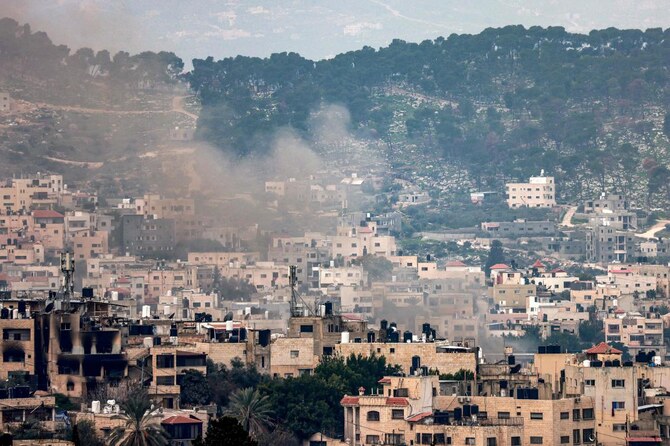BEIRUT: The Palestinian Hamas movement in Lebanon said on Saturday that the explosion that shook the Burj Al-Shemali refugee camp in Tyre city, southern Lebanon, on Friday night, was caused by an “electrical short-circuit in a storage area for oxygen bottles.”
Hamas members set up a security cordon around the explosion site on Friday. The resulting fire had injured a dozen people and caused significant material damage. No journalist was able to enter the camp to see what happened as the Lebanese Army cordoned off the area.
A Lebanese military source said on Friday night that “a fire in a warehouse of ammunition, weapons and foodstuffs belonging to Hamas led to the explosion.”
Video footage taken by camp residents showed red flashes coming out of the flames, followed by a huge explosion, which took place at Hamas’ Abi bin Kaab Mosque.
Some reported that there was a Hamas ammunition depot near the mosque that contained rocket-propelled grenades and bullets, while others suggested that Hamas stored oxygen bottles in that area for severe coronavirus disease (COVID-19) cases in the camp.
Camp residents shared video footage of the successive explosions that followed the fire, showing panic and chaos as people struggled to understand what was going on.
Houses and shops in the camp were significantly damaged and some cars were burnt. On Saturday, residents rushed to clear away the debris from shattered windows, doors and cars.
Camp residents reported that a dozen people were injured by the fire and the ensuing explosions. The fire was brought under control in the early hours of Friday night.
Neither Lebanese security forces, the army, internal security forces, nor any other security services ever enter Palestinian camps in Lebanon by virtue of an undeclared agreement between the Palestine Liberation Organization and the Lebanese authorities. Palestinian factions exercise self-security inside the camps but maintain close security coordination with Lebanese security services.
Noteworthy is that Lebanese security services prevent the entry of building materials and paint into the camps, but camp residents usually resort to smuggling these materials in order to repair their dilapidated homes.
A camp resident told Arab News: “The warehouse could have contained smuggled paint, in addition to fertilizers, both of which are flammable.”
The various Palestinian factions in refugee camps have light and medium weapons that occasionally come into sight in assassinations, attacks and clashes in some camps.
Palestinian refugee camps in southern Lebanon are mainly controlled by Hamas.
According to a Palestinian security source, “Hamas is trying to communicate with Lebanese diplomats as much as possible to make sure camps are kept away from any security operation in Lebanon that aims to implicate them. The rest of the Palestinian factions feel the same way and want to ensure the neutrality of Palestinian camps in Lebanon.”
The rocket launchers, which remained of unknown origin and through which rockets were fired in July and August toward Israel, were seized in the vicinity of the Burj Al-Shemali refugee camp.
The Palestinian security source told Arab News: “The factions refuse to be drawn into any attempt to make the camp bear the responsibility for these rockets. They have denied that camp residents had used those rocket launchers.”
On Saturday, a delegation from the UN Relief and Works Agency for Palestine Refugees in the Near East, consisting of the area director, the director of education, and the camp director, visited the Burj Al-Shemali camp area to assure the safety of refugees and staff, particularly in UNRWA schools close to the explosion.
According to a joint Lebanese-Palestinian census issued in 2017, about 10,218 Palestinian refugees live in the Burj Al-Shemali camp, 1,444 of whom were displaced from Syria following the events of the Yarmouk camp in 2011. Dozens of Lebanese and hundreds of Syrians also live inside the camp.



























